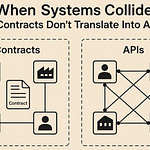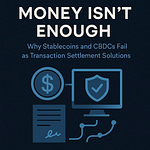1. The Fork in the Road
The internet is on the brink of its next foundational layer - one that promises to solve the problem the original designers left untouched: trust.
We can communicate instantly, globally, and for free. But we still cannot trust the identity of the sender, the integrity of the data, or the legitimacy of an action without relying on some external platform, authority, or gatekeeper. As digital transactions increase in complexity and consequence, the need for built-in, verifiable trust infrastructure becomes undeniable.
This is the promise of the Internet Trust Layer concept - an architectural solution to make identity, intent, and interaction verifiable as a function of protocol, not platform. It’s an ambitious goal, and a necessary one.
But as momentum builds, so does the tension. Because there is more than one way to design a trust layer. One path leads to a true network: open, protocol-driven, and decentralized - like the internet itself. The other path leads to a trust platform: centrally governed, compliance-oriented, and institutionally controlled.
Governments and legacy trust service providers are eager to define this future. They bring with them decades of experience in certificates, credentials, audits, and regulatory oversight. From their perspective, the trust layer must be aligned with existing legal frameworks, national infrastructures, and risk-based policies. They seek interoperability through public-private consensus, with governance committees and cross-recognition agreements guiding the outcome.
But consensus is not how the internet was built. The internet succeeded not because institutions agreed - but because protocols worked. It scaled because anyone could join by speaking the same language - IP, TCP, HTTP - not because anyone asked for permission.
The same choice is now in front of us again. Will trust be defined by protocol, or by policy? Will it scale through code, or through contracts?
The fork in the road is not just technical - it’s philosophical. It is about control versus coordination, governance versus emergence, centrality versus symmetry. And it matters now. Because once a trust infrastructure is in place, it becomes very difficult to unbuild. If we get it wrong, we may end up with a global system that is more bureaucratic than secure, more expensive than reliable, and more exclusive than open.
The next chapters will unpack this choice - by drawing clear lines between platforms and networks, identifying the architectural characteristics of each, and showing what’s truly at stake in the race to build the trust layer of the internet.
The goal is not just to critique. It is to clarify what makes a true trust network - and why we must insist on nothing less.
2. What Is a Network, Really?
We use the word network often - sometimes carelessly. Almost any system with multiple participants is labeled a network today. Social platforms, identity federations, centralized marketplaces - they all claim the title.
But not all systems that connect parties are networks in the architectural sense that matters here. Not every structure that links actors is capable of producing scalable, decentralized trust.
To understand what is at stake in the design of the Internet Trust Layer, we must return to first principles and ask: What actually makes something a network?
Protocols Over Platforms
A true network is defined not by who participates, but by how participation is governed.
In a network, the rules of interaction are expressed in shared, open protocols. These rules are enforced by the logic of the system itself - not by a central administrator or intermediary.
This distinction was critical to the internet’s success. It did not emerge from institutional consensus. It emerged from protocol convergence. Anyone could join - as long as they implemented the protocol. No one needed permission from a central operator. No one controlled the edges. The protocols ensured compatibility, and compatibility enabled scale.
Contrast this with platforms, which may expose public APIs and connect millions of users - but remain centrally governed, policy-bound, and operator-dependent. Their growth depends on the decisions of the platform owner. Their governance is vertical. Their innovation pathways are closed.
True networks, on the other hand, are horizontal. They scale by enabling direct interaction between autonomous peers. They evolve by composability, not by permission. Innovation in a true network does not wait for approval - it waits only for adoption.
Characteristics of a Real Network
There are certain irreducible features that define true network architecture:
Open access: Anyone who speaks the protocol can participate, without gatekeeping.
Peer symmetry: Every node can play any role - sender, receiver, issuer, verifier - without needing structural permission.
Built-in guarantees: Integrity, authenticity, and verifiability are achieved through the protocol, not institutional approval.
Loose coupling: Participants don’t need pre-existing relationships to interact. The protocol defines the rules of engagement.
No privileged observer: No central authority sees all interactions or has veto power over who communicates with whom.
This architecture is powerful because it pushes control to the edges. It allows systems to grow organically, participant by participant, without needing pre-defined trust registries, legal contracts, or master data integrations.
It is also resilient. There is no central point of failure, no single point of policy capture. It’s why email, despite its age, still works across providers and across borders. It’s why the web survived and outpaced all its competitors. And it’s why, if we are to solve trust at the global scale, we must return to these same principles.
The Illusion of the “Network” Label
Many of today’s so-called “trust networks” violate nearly all of these principles. They are organized as clubs - requiring formal onboarding, approved software vendors, and policy alignment. Trust is not verified at the protocol level, but granted by recognition between central authorities. Verifiability is replaced by certification. Interoperability is negotiated, not assumed.
They are not networks. They are federated platforms.
And once embedded in digital infrastructure, their control structures harden. Onboarding becomes more complex. Innovation becomes slower. Trust becomes a matter of legal alignment rather than cryptographic proof. The system drifts further from the internet model and closer to the old-world logic of institutional intermediation.
This is not a technical inconvenience. It is an architectural betrayal.
Because the moment trust becomes a service sold by platforms, rather than a protocol implemented by peers, we lose the very property that made the internet transformative: its openness.
In the next chapter, we’ll explore the anatomy of platforms in more detail - and why they remain the dominant mental model for today’s trust service providers. The difference isn’t just technical. It’s conceptual. And the cost of confusing the two is higher than most recognize.
3. Platforms Are Not Networks
As the language of trust infrastructure becomes more fashionable, the word network is often applied to systems that do not deserve it.
At first glance, the distinction between a platform and a network might seem academic. Both connect users. Both offer services. Both can scale.
But under the surface, their architectures - and their implications - could not be more different.
This chapter makes the case plainly: platforms are not networks, and mistaking one for the other will quietly shape the future of digital trust in ways we may not be able to undo.
Control Is the Tell
The defining feature of a platform is control - centralized, asymmetrical, and enforced from above.
A platform governs participation. It decides who may enter, what actions are allowed, and what data is exposed. Even if it offers open APIs or supports third-party modules, the logic of the system remains vertically integrated. Trust flows from the center. Power accumulates there too.
Participants on a platform are not peers. They are users. They are subject to terms and conditions they did not negotiate. They do not control the logic of the system, nor can they shape its evolution unless the operator allows it.
This control is not inherently malicious. In many cases, it is the reason platforms scale quickly and appear to offer trust. But the trust they offer is always conditional, revocable, and tied to the business model of the provider.
Now consider what happens when trust infrastructure - identities, credentials, attestations - is embedded in a platform logic. It becomes a service. An offer. A business arrangement. Participation becomes gated, qualified by compliance, and constrained by terms of use.
This is what’s happening now in the emerging landscape of digital identity and verifiable credentials.
Governments and large trust service providers are building what they call networks. But these are, in practice, platforms with policy wrappers. Participation requires being recognized by a scheme. Issuance requires registration. Verification requires integration. Every action flows through a platform-shaped lens of compliance and control.
It’s not a network. It’s a federation.
Platform Logic in Disguise
These “federated trust frameworks” often attempt to simulate network effects by coordinating across many participants. There may be dozens or hundreds of issuers and verifiers. There may be national and sectoral nodes, even cross-border recognition.
But they do not behave like networks. They behave like clubs. Their rules are fixed by agreement, not by protocol. Their interoperability is negotiated, not assumed. Their growth is managed, not emergent.
Such systems carry the illusion of openness while quietly enforcing the constraints of a platform. They give the impression of decentralization while centralizing the right to define who can trust whom.
This is not a technical footnote. It is a structural flaw.
Because once trust flows through platforms, trust becomes an institutional product - not a protocol property. And once that shift is made, the architecture no longer scales by design. It scales only by governance.
That is not the internet model. That is the enterprise IT model - redesigned for public-private consensus.
The Hidden Cost of the Wrong Model
At first, a platform-based trust infrastructure may seem safer. More controlled. Easier to govern.
But over time, its weaknesses emerge:
It requires every new participant to be onboarded by a gatekeeper.
It slows innovation by tying new interactions to approval processes.
It centralizes liability and concentrates risk.
It reduces trust to a matter of reputation, not verification.
It makes the system brittle - dependent on the solvency, availability, and politics of its operators.
Worse, it habituates an entire generation of digital actors to think of trust as something granted by institutions, not as something provable by protocol.
This is the long-term cost of mistaking platforms for networks. We don’t just constrain functionality. We constrain imagination.
The next chapter will offer an alternative. If platforms are the wrong model, what does a true trust network look like - and how can we ensure that the next layer of the internet reflects its values?
We will examine seven core requirements for trust as a network protocol, and what each one makes possible.
4. Seven Criteria for a True Trust Network
If platforms can’t deliver a scalable, verifiable, and open layer of trust - what can?
The answer lies in the architecture of networks. Not metaphorical ones, but true protocol-based networks. Ones that inherit the structural advantages of the internet itself: decentralization, interoperability, and resilience. For trust infrastructure to scale and serve as a public good, it must operate according to these same principles.
This chapter outlines seven essential criteria that distinguish a true trust network from any federated or platform-based alternative. Each criterion is not merely technical - it defines what kind of digital society the infrastructure will enable.
1. No Central Control Point
A real network allows anyone to participate without asking for permission. There is no root authority that approves identities, defines policy, or governs access. Instead, control is distributed to the edges - where participants authenticate themselves using cryptographic credentials and verifiable data.
In a trust platform, there is always a gate.
In a trust network, there is only a protocol.
Without this, trust is not durable - it is conditional. And conditional trust does not scale globally.
2. Protocol-Enforced Rules, Not Policy-Enforced Access
In a true network, the rules of engagement are implemented as protocols, not legal contracts or trust frameworks. Interactions are verifiable based on data structures and signatures - not based on compliance with sector-specific onboarding documents.
The browser doesn’t check if a website is in “good legal standing.”
It checks if the certificate matches the domain. That’s protocol-level trust.
If access is granted based on interpretation of policy documents, you’re not using a network - you’re applying for a license.
3. Peer-to-Peer Symmetry
All actors in the network are peers. An identity provider today can be a verifier tomorrow. A contract agent can issue credentials in one context and rely on credentials in another. This symmetry is crucial - it enables flexibility, resilience, and evolution.
Platforms enforce roles: issuer vs verifier, user vs admin, subject vs operator.
Networks support fluidity. Participants choose roles at runtime, within the bounds of protocol.
As soon as a system fixes identity roles in the architecture, it locks in hierarchy. That’s not a network; that’s an application.
4. Composability Without Negotiation
New interactions should not require new integrations. Trust networks must be composable - allowing participants to combine credentials, agents, and contracts in novel ways without bilateral agreements.
This is how email works. No need to ask for permission to add a new attachment format or use a different provider.
As long as the protocol is followed, the interaction succeeds.
Composability enables innovation. Negotiation slows it down. If each new trust use case requires legal work, it’s not a network - it’s a patchwork of contracts.
5. Built-In Verifiability
Trust is not granted in a network - it is proven. Identities, data, and actions are verifiable through cryptographic signatures and standard formats. Every claim can be traced to a credential. Every credential to a key. Every key to a known root of trust.
If a verifier must contact an issuer to “check if something is still valid,”
the system is not verifiable. It is merely referential.
A real trust network minimizes assumptions. It does not require trust in people or institutions - it requires trust in math.
6. Public Specification, Private Participation
Protocols must be publicly documented and accessible. But participation in the network must remain private. Agents can choose what to disclose, to whom, and when. No global registry. No mandatory publication of metadata. No central observer.
The internet allows anyone to run a server without announcing it to the world.
Trust networks should do the same for agents and credentials.
If participants must enroll in a global trust scheme to interact, privacy is lost before trust is even formed.
7. Interoperability Over Integration
Interoperability means two parties can interact without prior arrangement. It is what made the internet unstoppable. If trust requires back-end integration between institutions - or bilateral agreements between credential issuers and verifiers - it’s not interoperable.
Trust networks should behave like the DNS:
decentralized, composable, independently maintained.
Integration is the enemy of scale. Interoperability is the engine of it.
The Sum of the Parts
Each of these criteria may sound small in isolation. But together, they define a philosophy of architecture.
A trust layer built on these principles behaves like infrastructure - not a service. It becomes a foundation others can build on, without fear of lock-in, deplatforming, or political capture.
More importantly, it opens up the space for new types of participants - those not already inside the walled gardens of today’s institutions.
That’s the power of protocol-level trust: it levels the playing field.
In the next chapter, we’ll explore why the public-private consensus model - the one currently gaining traction in digital identity and trust services - defaults to platform thinking. Not because it’s malicious, but because it’s familiar. Because that’s how institutions have always solved problems: by creating structures of control, not protocols of freedom.
5. The Institutional Temptation
It’s easy to imagine that the growing momentum behind digital trust infrastructure - national eID systems, cross-border credentialing, regulated trust schemes - is a sign that the right foundation is finally being laid. Governments are involved. Standards bodies are active. Industry coalitions are forming. There’s consensus, funding, legislation.
Surely this must be the beginning of a new kind of digital public good?
But momentum is not direction.
The model now being built - through the consensus of governments, large institutions, and established trust service providers - is not a protocol-based trust network. It is an institutional overlay on top of digital interactions. A compliance architecture disguised as infrastructure.
To understand why this is happening, we must look not just at how institutions operate - but at how they think.
Institutions Solve Problems With Control
Institutions exist to reduce uncertainty. Their power comes from creating rules, enforcing boundaries, and centralizing authority. That is their function - and it works. It’s how public health, taxation, and financial supervision have scaled to billions of people.
When institutions look at the problem of trust on the internet, they reach instinctively for the tools they know:
Registries to know who’s in.
Licensing to enforce obligations.
Liability frameworks to define consequences.
Governance committees to define interoperability.
Audits and certifications to signal trustworthiness.
This is not bad faith. It is institutional reflex.
But when applied to the Internet Trust Layer, these tools produce systems that may appear digital, but are structurally institutional. They reproduce control structures, not protocols.
The Familiarity of the Federation Model
The trust service industry - rooted in PKI, CA hierarchies, and eIDAS-style schemes - shares this institutional mindset. For decades, digital trust has meant one thing: certificate-based identity issued under strict legal and organizational oversight.
It’s no surprise, then, that today’s trust services are building “networks” that mirror these old patterns:
Closed schemes with curated participants.
Cross-recognition models that require legal alignment between authorities.
Central trust lists maintained by a designated supervising body.
Strict role segregation: issuers issue, verifiers verify, subjects comply.
This model is not being challenged - it’s being scaled.
And so the Internet Trust Layer, as imagined by many of these actors, is not a layer at all. It is a collection of interoperable platforms, governed by policy alignment, implemented through proprietary stacks, and operated by consortiums with strong gatekeeping mandates.
It uses network terminology, but it enforces platform rules.
Why Consensus Doesn’t Build Networks
Public–private consensus feels like progress. It looks collaborative. It avoids confrontation. But consensus does not create protocols. It creates agreements - legal, political, procedural. These agreements need enforcement. Enforcement needs control. Control needs centralization.
That is how consensus inevitably slides into institutionalism.
The protocols that built the internet were not the result of public–private consensus. They were built by communities of engineers solving real problems at the protocol level - not waiting for legal alignment before publishing a spec.
The reason TCP/IP, DNS, and HTTP worked is not because they were ratified by all governments or regulated industries. It’s because they defined interaction rules so clearly, and so verifiably, that anyone could implement them - and know they would work.
That is not how the current trust schemes operate.
Institutions Don’t Scale the Way Protocols Do
Even with goodwill, public–private trust infrastructure has natural limits:
It takes years to agree on shared policies.
Cross-border interoperability depends on legal treaties and political alignment.
Innovation is bottlenecked by certification cycles and vendor dependencies.
Participants are limited to those who can navigate the regulatory requirements.
This does not create an open layer. It creates a regulated club.
Even worse, once this model becomes entrenched, it becomes hard to replace. Protocol-based alternatives will be labeled “non-compliant.” Institutions will resist delegation of trust decisions. The network effects of controlled trust infrastructure will slowly lock in a future no one explicitly chose.
The Real Danger: Mislabeling the Architecture
If institutions built platforms and called them platforms, the choice would be clear.
But when these structures are labeled “networks,” and consensus-based schemes are marketed as “public infrastructure,” the distinction becomes blurry - and public understanding collapses.
That is the real danger. Not just control, but the illusion of neutrality.
In the next chapter, we’ll look ahead: What happens if this model succeeds? What kind of digital trust architecture will we inherit - and how will it shape innovation, privacy, and inclusion in the years to come?
6. What Happens If They Succeed?
Let’s imagine the institutional model for digital trust infrastructure succeeds.
The regulations are passed. The schemes are rolled out. Governments, trust service providers, and industry alliances align. Credential formats are standardized. Identity wallets are issued. Interoperability agreements are signed.
From the outside, it looks like progress.
But step inside the architecture - and it quickly becomes clear what kind of infrastructure we’ve built.
A Gated Internet of Identities
In this world, identity is a license, not a tool.
Every digital actor - person, business, device - must acquire credentials from a pre-approved authority. These credentials are only valid within certain schemes, sectors, or jurisdictions. Their scope is predefined. Their revocation is external. Their reissuance is bureaucratic.
To interact with others, your credentials must be recognized by their trust framework. If they aren’t, the interaction fails - not because it’s unsafe, but because it’s unauthorized.
Trust becomes conditional, contextual, and fragile.
This isn’t digital sovereignty. It’s digital dependency.
Innovation Slows to a Crawl
In such a system, permissionless innovation becomes impossible.
Every new role - issuer, verifier, wallet provider - requires regulatory approval or onboarding. Every new interaction pattern must align with pre-existing schemes. Every attempt to recombine credentials across domains raises legal questions.
Startups can’t just ship software. They must submit it.
Developers can’t just build features. They must get them certified.
No one innovates at the edge - because the edge is fenced.
The result is a brittle ecosystem: compliant by design, inert by consequence.
Cross-Border Trust Becomes a Legal Project
Global interoperability becomes a matter of treaties, not protocols.
For one country’s credentials to be trusted in another, their authorities must align policies, legal liability, governance structures, and dispute resolution. This takes years - sometimes decades. In the meantime, cross-border transactions fall back to the old model: manual reviews, bilateral agreements, or full exclusion.
The internet made communication global from day one.
This model reintroduces borders - just dressed in digital clothes.
Trust Service Providers Become Rent-Seekers
As credential issuance becomes mandatory, trust service providers become gatekeepers.
They charge fees for issuance, renewal, revocation, and integration. They accumulate data, influence, and revenue - not from adding value, but from sitting at the bottlenecks of interaction. Over time, the incentives shift from improving the system to defending their position in it.
A credential model built on institutional control eventually collapses into an economy of friction - one that charges rent on trust itself.
Privacy Becomes a Managed Exception
Although privacy is often a stated goal of institutional trust schemes, it becomes an exception - something negotiated through compliance mechanisms rather than enforced by protocol.
Participants are asked to reveal more than necessary to meet verification requirements. Consent becomes bundled. Data minimization becomes theoretical.
In edge cases - whistleblowers, dissidents, excluded populations - there is no fallback. No peer-based verification. No self-issued alternatives.
In the name of trust, the system erodes the very autonomy that digital infrastructure is meant to protect.
The Surface Is Shiny, The Foundation Is Fragile
In the short term, everything works. Credentials are issued. Use cases are piloted. Institutions celebrate interoperability.
But underneath the surface, the model is fragile:
It relies on institutional continuity and political will.
It excludes those who can’t or won’t align.
It cannot adapt to new use cases without new governance cycles.
It does not scale beyond the pre-defined edges.
And crucially: it teaches an entire generation that trust is something granted to you - not something you can prove, own, or build yourself.
We Will Have Lost the Plot
If this model succeeds, the trust layer for the internet will not be a trust protocol.
It will be a compliance machine.
A global infrastructure of interlocking platforms and credential providers, optimized not for coordination - but for control.
And once embedded, it will be hard to undo.
By the time we realize what we’ve lost - permissionless entry, peer-to-peer trust, innovation at the edge - it may be too late to reclaim it.
In the next chapter, we’ll shift from prediction to possibility: what happens if we succeed in building the alternative? What could the world look like if trust is treated not as a service to be granted, but as a protocol to be implemented?
7. What Happens If We Build the Alternative?
Now imagine the other path. The institutional trust schemes falter - not because they fail outright, but because they can’t keep up. They can’t onboard fast enough. Can’t scale across borders. Can’t meet the demand for flexibility, privacy, or speed.
Into that gap emerges something else. Something smaller, simpler, and more powerful:
Trust as a protocol.
Built like the internet was built. Grown from working code, not working groups. Adopted because it works, not because it’s regulated. This chapter is a guided look into that future.
Anyone Can Issue. Anyone Can Verify. Anyone Can Build.
In a protocol-based trust network, every participant is a sovereign actor.
If you can prove your identity cryptographically, you can issue credentials. If you can verify digital signatures, you can consume them. If you can implement the protocol, you can participate fully - without registration, integration, or approval.
Startups can create new trusted transactions overnight. Banks can issue attestations that verifiers in other countries can instantly check. End users can hold credentials from dozens of issuers and present them selectively, privately, and on their own terms.
Innovation happens at the edges. The core protocol remains stable, minimal, and open.
Trust Emerges, Rather Than Being Granted
This is the most important shift. In the institutional model, trust is pre-negotiated: Issuer A is trusted because Regulator B approved them. Credential C is valid because Scheme D says so.
In the protocol model, trust is post-negotiated: You receive a credential from someone you already trust - or you evaluate its cryptographic proof, issuer history, or metadata at the moment of need. You’re not forced to trust anyone. You’re free to build your own trust graph.
Institutions don’t vanish. They simply become participants—not gatekeepers.
Cross-Border Just Works
Because there are no central authorities or national registries controlling the protocol, cross-border interaction is not an exception. It’s the default.
You can verify a credential issued in Japan, presented in Nigeria, and processed by a company in Brazil - because all three speak the same protocol.
If you don’t recognize the issuer, you don’t trust the credential. That’s your choice.
But you don’t need a treaty to process the packet.
That’s what makes it internet-native.
Credentials Are Portable, Private, and Programmable
Users hold their credentials in their own agents. These agents don’t broadcast. They don’t register. They don’t call home.
No third-party tracking.
No silent revocations.
No credential blacklists unless you subscribe to them voluntarily.
Even better, credentials can be composed. You can combine them, reuse them, split them, create sub-claims. Protocol logic enables dynamic use without centralized rules.
It’s the difference between showing your ID card… and proving just your age.
Trust Scales Like Software, Not Policy
When a new use case emerges - say, decentralized insurance underwriting or cross-border supplier verification - you don’t need a committee. You just define the new credential type, sign it with your existing key, and let the market evaluate its value.
You don’t need to integrate. You don’t need to register. You just speak protocol.
That’s how scale happens. That’s how systems grow - not by aligning governance - but by reducing friction.
This Isn’t a Dream. It’s a Design Choice.
The architecture for this future already exists.
Decentralized identifiers (DIDs)
Verifiable credentials (VCs)
Trust-capable agents
Cryptographic protocols for proof, delegation, and audit
These are not science fiction. They are building blocks.
What’s needed is not permission - but discipline: A commitment to protocol-level trust. A refusal to reintroduce central authority through convenience or compliance theatre.
The open model isn’t slower. It’s simply not institutionally convenient. But it is systemically transformative.
In the next chapter, we’ll trace the roots of this model - back to the early internet protocols - and show how the same architectural logic that enabled communication to scale can now be used to make coordination scalable, verifiable, and trust-minimized.
The jump from TCP/IP to ITL is not a reinvention. It’s a continuation.
8. From TCP/IP to ITL: A Historical Parallel
The success of the internet was not inevitable. In its early days, it competed with other models - centralized telecommunication systems, proprietary protocols, and tightly governed industry networks. Many of these alternatives were more mature, more compliant, and more comfortable for institutions. Yet they failed to scale.
What won was not a better product - it was a better architecture. The reason the internet overtook its competitors wasn’t because it was perfect, but because it embodied a simple design principle: the protocol is the interface.
The same principle now lies at the heart of a new transformation. This time, the problem isn’t communication. It’s coordination. And the leap forward is not TCP/IP - it’s the Internet Trust Layer (ITL).
This chapter maps that transition - and explains why we’ve been here before.
TCP/IP: The Protocol That Ignored Institutions
When TCP/IP was proposed as the standard for packet-switched networking, it didn’t align with the structures favored by governments or industry consortia.
It didn’t include billing systems for telecom operators. It didn’t offer centralized traffic control. It didn’t enforce authentication or pre-approved access. Instead, it assumed the opposite:
That anyone could create an address.
That nodes would forward packets without knowing their contents.
That applications would define their own semantics.
It was the radical idea that the edges of the network - individuals, devices, organizations - could coordinate freely if the protocol guaranteed only the most essential properties: delivery, order, and reachability.
It minimized assumptions and maximized freedom.
And it scaled beyond anything imagined at the time.
The Trust Problem: Coordination Without Control
Today, we face the next frontier: not just communicating data across networks, but coordinating trust across independent actors.
How do I know who you are? How can I verify the origin and integrity of your claims?Can I rely on your commitments - and automate my response?
The answers so far have followed institutional logic: use legal frameworks, centralized authorities, and policy-based gatekeeping. But these systems don’t scale across borders, sectors, or use cases.
We need an equivalent of TCP/IP for trust. That is what the Internet Trust Layer aims to become.
ITL: The Protocol Stack for Verifiable Coordination
Where TCP/IP defined how packets move across machines, ITL defines how claims, credentials, and commitmentsmove across identities.
Its core principles echo those of the early internet:
No central control point - anyone can issue, verify, or participate.
Minimal protocol requirements - cryptographic proof replaces trust in intermediaries.
Layered design - identity, data, and coordination are modular and interoperable.
Edge autonomy - agents hold their own credentials, keys, and execution logic.
ITL doesn’t tell you who to trust. It lets you verify what you need, from whom you choose, in the context that matters. It doesn’t define policy. It defines interaction. And just like the early internet, it will look messy at first—because it allows diversity, not control.
But like TCP/IP, its simplicity makes it portable. Its generality makes it universal. And its structure makes it resilient.
Why This Parallel Matters
The institutions trying to build trust infrastructure today are making the same mistake telecoms made in the 1970s and 80s.
They’re designing for enforcement, not enablement. They’re protecting old structures, not imagining new possibilities. They want the digital economy to grow - but only within the boundaries they control.
But boundaries don’t scale. Protocols do. We know this. We’ve seen it. And now we face the same choice again.
In the final chapter, we’ll return to the present moment. The fork in the road is real, and the time to choose is now. We will close by reframing trust itself - not as a permission to act, but as a property of action that can be proven, verified, and built into the fabric of the internet.
9. Conclusion: The Choice Is Now
We stand at a critical juncture in the evolution of the digital world.
The first internet gave us communication. The second is poised to give us trust. But only if we choose to build it the same way - as a protocol, not a platform.
The decisions being made now - by regulators, institutions, and standards bodies - will shape the structure of digital interaction for decades to come. They will determine whether trust becomes verifiable and universal, or managed and conditional.
The signs are clear: the prevailing model is drifting toward the latter.
It is structured around schemes, registries, certifications, and pre-approved roles. It assumes that trust is something to be granted by those in power, enforced through policy, and consumed through integration. This logic may be familiar. It may feel safe. But it is not how networks scale.
It is how systems stall.
Trust Must Be Treated as Infrastructure
Trust is not a service to be offered. It is a property to be proven.
The internet doesn’t ask permission to transmit a packet.
A real trust network shouldn’t ask permission to verify a credential.
If the Internet Trust Layer is to serve as a true foundation, it must be protocol-native:
Governed by shared rules, not institutions.
Enforced by cryptography, not contracts.
Accessible to all, not just those in the scheme.
Like TCP/IP, it must disappear into the background - simple, universal, and powerful in its constraints. Only then will it support the kind of innovation, resilience, and inclusion that the digital economy now requires.
A Call to Architects, Engineers, and Institutions
This is not a battle between public and private, or open and secure. It is a question of design principles.
If we design for protocol-level trust, institutions remain free to play their rightful role: not as gatekeepers, but as participants - trustworthy by virtue of the credentials they issue, not the control they exert.
But if we delegate the design of trust infrastructure to institutions alone, we will get what institutions always build: platforms, not protocols. Services, not networks. Intermediaries, not infrastructure.
The window to choose is small. Once the ecosystem is defined by control points, lock-in sets in. Alternatives will be labeled non-compliant. Composability will collapse. And the path not taken will be closed to all but the most radical.
The Future Is Verifiable
The good news is: the alternative is not theoretical. The core standards exist or are easily modifiable to fit the bill. The community is growing.
What remains is to defend the architecture - not by lobbying, but by building. By refusing to reintroduce gatekeepers through backdoors of convenience. By insisting that trust belongs at the protocol layer.
Because we’ve seen this movie before. And we know how it ends - when we build the right foundations.
Let trust be something you prove - not something you’re granted.
Let networks emerge - not be managed.
Let the next layer of the internet be worthy of the one we already have.
The choice is now.










